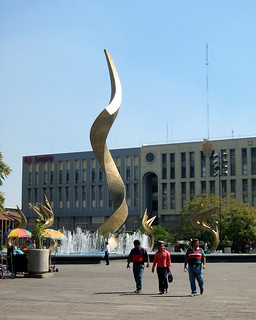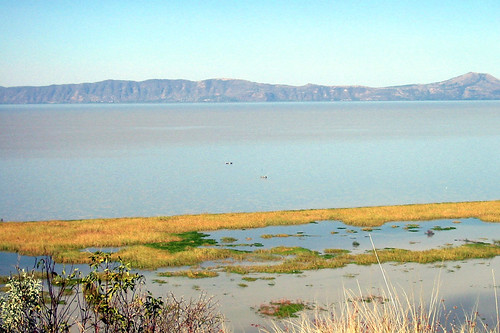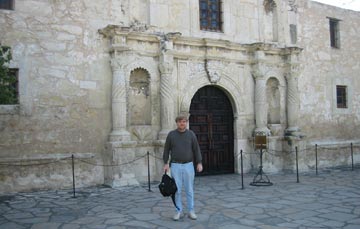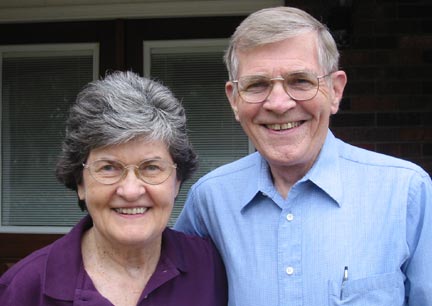February 28, 2004
Guanajuato
Before moving on to Guanajuato, I will wrap up my activities in Morelia.
On Tuesday night, after my last journal entry that afternoon, I returned to Porfirianas. I ordered a beer with lime and played a game of pool by myself. Three guys and a girl were playing dominoes. They occasionally watched my play. After I was done and sipping my beer they asked if I would like to play with them. I asked if they knew the rules, because I have seen some sloppy play here. They assured me that they knew them. It was David and Louis against Romero and me. We were pretty evenly matched for skill, in other words - we were not the greatest of players. What I liked best is that we won almost all the games. We were certainly slightly better in most of the games, but often David and Louis excelled only to scratch on the eight ball. The one rule that they did not know was the scratch rule when you do not hit your own ball first. It took a while to explain, but they finally got it. I explained that the penalty was either two shots for the opponent or they had to spot a ball. On a table where you can pull the balls, one usually spots a ball, which should have been the case here. However, they decided the penalty would be two shots. They seemed to like this rule, especially when I missed the eight ball all together and lost the game. Romero had a car parked out front and gave me a ride to my hotel. We agreed to meet the next night, but we did not connect, which I was very sorry about.
Press HERE to see a slideshow
of Guanajuato and San Miguel.
Views of Guanajuato
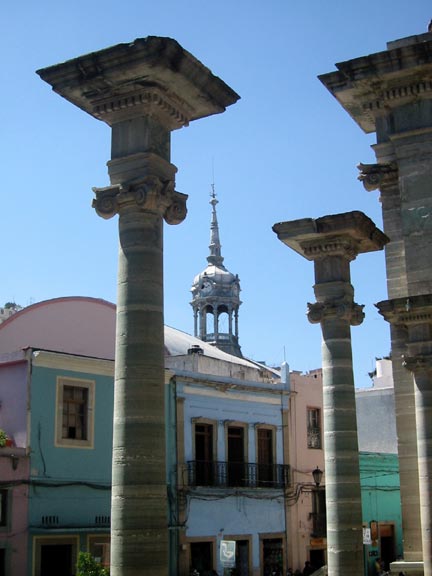
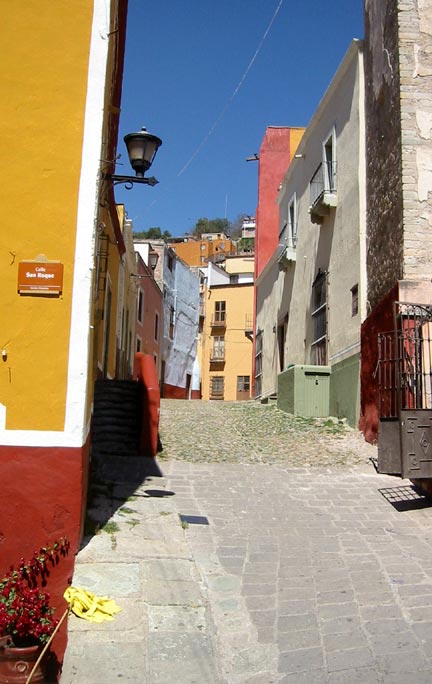
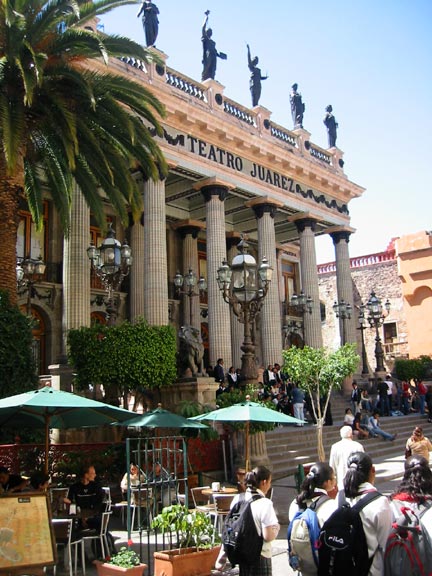
I had planned to do next to nothing on Wednesday, and I pretty much succeeded. I slept latter than usual, although I have not been getting up all the early. It was eleven before I walked out of my hotel for breakfast. I hopped in the car and drove to a larger park near the medical school. I tried to study Spanish, and did but it was a far cry from my studies in Guatemala. I really need a teacher like I had there. My Spanish seems to disappear when I return to the States. It is coming back, but without a guide it is coming fairly slowly. I am probably ready for another trip to Antigua. In any case, I sat and studied and observed for three or so hours. Eventually, I made way back to the hotel for a nap. Then it was back to the restaurant by the little plaza for a glass of wine. I was beginning to tire of the Mexican fare, so I decided to go Italian. I found a nice restaurant that was a notch above the ordinary. The meal was very good: veal marsala with pasta, salad and a glass of wine - all for only $16 USD. I actually was in bed by ten, but the TV kept me up until after eleven.
Thursday, February 26, 2004:
I was up early, packed and headed north to Guanajuato. The free road was far better, mostly four-lane too. I passed through some beautiful territory in the 100 miles. There is a great lake about 30 miles north of Morelia. There were lots of rich farm fields between there and Salamanca. It was actually green. I think they raise a lot of strawberries around here, based on all the stands with signs selling them. But north of there, it got very dry again. The vegetation reminds me a lot of the area around Cuernavaca. And how dry is it. More often as not, the dry grasses have burned back from the road more than 300 yards - and often much more. I have not mentioned how often the fire has raged along side the road. It has been too often that I must drive through the smoke or worst yet the flames.
I arrived in Guanajuato in the early afternoon. This is a small city of 75,000. It is so different. The first thing that you notice as you drive in is that it is honeycombed with tunnels under the city. Why? It is built in a crevasse between high hills. It is so confusing when you are underground, that I was maddening for a guy like me who can usually find his was around every city. Even with a map it is difficult, because one cannot be sure about the level of the road on the map. Parking in el centro is nearly impossible. There are a few pay lots at 8 pesos an hour. Not outrageous for a shopping trip but not something you want to pay 24 hours a day on top of a hotel. I found my way to one of these parking ramps near several cheap downtown hotels. It didn't long to figure out that I would not stay there.
I did spend some time trying to get my phone working. I did figure out how to call for info. It seems that my first 200 pesos evaporated. As most modern conveniences, telecommunications are incredibly expensive here. There is probably a state monopoly on the trunk line services. I discovered that my cost twice what they assured me it was for roaming and the cost to the USA was a total shock - 15 pesos per minute. No more cell phone calls home, still even to receive a call outside of Morelia is 4.25 pesos per minute or 40 cents per minute. I was told about a special being sold at a particular store, but guess what - they had no cards at both that I check at. In the USA we would call such a practice unethical at the least.
I figured to settle a bit from the center. To tell the truth is probably less than a half-mile to the center. I am paying a lot more ($32 USD per night) than in Morelia ($18 USD). This hotel actually has a restaurant, besides a parking lot.
There appear to be a good number of American students, tourists and even some expats here. In the evening I got a glimpse of them all. I walked to the main plaza for evening activities, Jardin de la Union. I had one of those unexpected moments of pure glee as I entered the square. There were hundreds of people, mostly students from the nearby university. I the plaza in lined with restaurants, and bars. An old theater is across a very narrow street. I ate a restaurant 20 yards from the square, watched a footfall game and was serenaded by a troubadour. After diner, I just sat on a bench on the plaza. I struck up a conversation with the gentleman sitting next to me. His name was Jerold and he was a young lawyer, working for the government. We talked quite a bit. He has a wonder lust to visit the northern forested areas of the world: Canada, the USA, Sweden and Finland. I can tell that he needs to escape the desert that he has live in most of his life. A little after ten, I wandered 50 or so yards over to El Bar. I mainly went to watch the salsa dancers. Some of them were fantastic. I kept on thinking how much Gitta would enjoy a place like this. At moments like that, I feel sorry for her NYC existence. Ah the simple, oh yes now I remember why NYC, and poor life of Mexico. Well maybe it is not so poor. It is one of the more expensive places in Latin America. It is still cheaper than Canada, yet developing quickly. One thing that I hope will never change is the music and the people. I left the bar after an hour, and was headed back to my hotel when I heard some live jazz flowing from a second story bar. I had to stop and listen. I was a very small place, but I was surprised to find it seven or eight younger American women partying. Finally, the music ended a little after midnight. I was on my way out when I received some nice invitation to continue the festivities. I politely decline and got an invitation to return the next evening.
Friday, February 27, 2004:
I slept way too late, but - what the hay - this is a vacation. I just wanted to see the city and find a cheaper place to stay. So as I walked through the city I stopped a few hotels. The main part of the city is even smaller than I thought, but Gerardo has told me that twice as many people - 140,000 - live in the city than stated in the guide. He also told me that San Miguel de la Allende is much larger than Guanajuato. Again this is very different from the guide books, leaving me to speculate that these cities are rapidly changing. The city has a large number of streets dedicated to pedestrians. Most streets that allow cars are very narrow - just wide enough for a single car. There are a few streets with two way traffic, but I think this is to allow access to the tunnels under the city. Most buildings are from the 1800's. It is so picturesque. The streets and many small plazas are never empty.
Diego Rivera was born and lived in this city as a young boy. There is a small museum dedicated to him, and it resides in the house were his family lived. The first floor has some period furniture, said to be his family's furniture. The second and third floors are dedicated to his works. His early works show his growth and learning as an artist, in other words they are not that great. His works of the 30's and 40's a wonderful. There was a good variety of his pieces: portraits in oils and ink, simple pieces describing ancient Mexican-Indian tales and myths, and the occasional landscape. I enjoyed this museum a lot.
Tired from the walking, I settled in the Jardin de la Union for a couple of beers and a bit of music from the minstrels wandering the square. I headed back to my hotel for a nap.
In the evening I ate a great diner. Food is cheap here; at this very good restaurant, the steak diner with wine still only cost less than $14 USD. After diner I spent a good amount of time talking Jerald. He met a young Uruguayan woman on the internet. Despite his meager government wages, he has been able to visit her several times in Uruguay. He tells me that she is a first-year university student. They plan for her to come here this summer and that they will marry. We visited the El Bar, where the music was loud and not many people were there. Perhaps it is too early. After one drink we left. He works on Saturdays, and needed to retire for the evening. As I walked back to my hotel, I looked in a couple of other bars. I stopped a one to listen to a bit of live music and another glass of wine.
I must say that I like Guanajuato a lot.
It is more than charming with its colonial motif. The university gives it an intellectual life. It public spaces are wonderful and often full of people. I will stay one more night before departing for San Miguel.
Houses on the Hills of Guanajuato
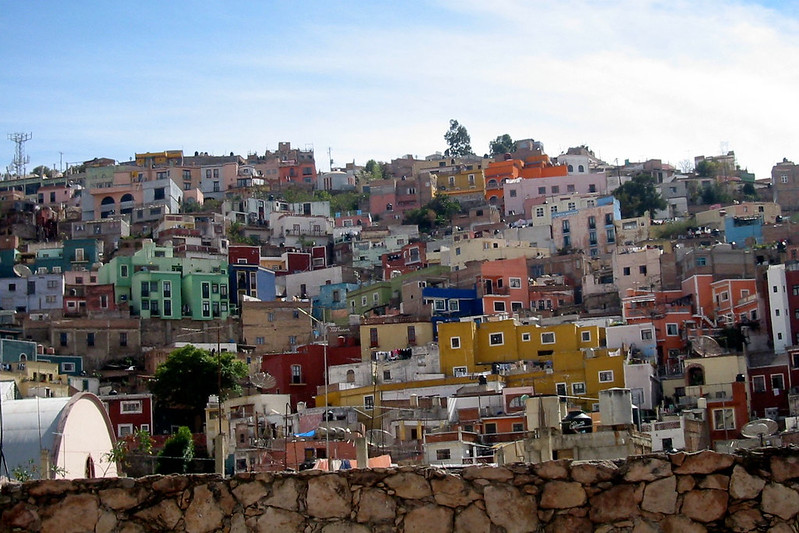
February 26, 2004
A Note from Cambodia
Last year, while traveling in New Zealand, I ran in to a Brit living in Thailand. His name is Alan Puzey. We exchanged email addresses, and stayed in contact. While I was in Thailand and India, he was crossing the USA.
On Wednesday, I received an excellent report on his recent trip to Cambodia.
You will find a copy of his message by pressing the "Continue reading" link below.
From: Alan Puzey
Subject: CAMBODIAN REPORT
Date: Mon, February 23, 2004 10:13 am
To: Bill@Sundstrom.us
--------------------------------------------------------------------------------
02 - CAMBODIA
When you delve into the Lonely Planet guide, you may be daunted by the ten pages on health issues; hepatitis, HIV, Dengue Fever, malaria, rabies, cholera - all the usual suspects - plus leeches, snakes, worms; and if these don't get you - landmines, street crime, scams, begging and road accidents still might!
So, it was with a little trepidation that Bryan and I embarked on an eleven day trip, taking in Siem Reap, Angkor and Phnom Penh, little knowing at that time what a successful trip it would turn out to be with nary a mishap and much enlightenment en route.
A President Airlines (Cambodian) round trip; Bangkok > Phnom Penh > Siem Reap > Phnom Penh > Bangkok cost just $210, but to this had to be added another $37 as there is a charge for every Cambodian airport passed thru, regardless of whether you stop over. How these charges continue to mount up, all around the world! Every flight was in the same Boeing 737, so perhaps they just have the one plane; however, every flight was smooth and fine. Cambodia uses US dollars for all major transactions and a local currency (the riel, with 4,000 riels to the dollar) mainly for local people and minor items. We both took $500 for the eleven days and returned with about $50 each - so were riel millionaires for a while! Bangkok to Phnom Penh takes 70 minutes and Phnom Penh to Siem Reap 45 minutes.
A 25 minute taxi ride from the airport to Siem Reap was just $1 and we were taken to a couple of new hotels, one of which we chose at $17 for a twin. It was fine and one of a number of very new hotels recently built for the influx of tourists to the Angkor sites. Siem Reap proved to be a charming little town for a stay, with a 'frontier' atmosphere of dusty, dirt-track roads, little or no lighting at night and pockets of activity around the tourist areas.
Our evenings here were taken up with choosing which of the fifteen odd 'local' restaurants to eat at - all of which proved tasty and very good value, imbibing the local 'Angkor Beer' which was very good, playing some pool and watching televised football. There were plenty of police on the streets around the tourist area and no signs of trouble.
The first couple of days were spent settling in, exploring the town (doesn't take long, but it was hot of course) and finding our feet. The next three days were centred on viewing the Angkor sites. The first two days we got there and explored under our own steam, on hired bicycles, and on the third day we hired a rickshaw wallah to drive us around the outer sites. Tickets to enter Angkor are $20 for one day, $40 for three days and $60 for a week. We chose the happy medium and most people do, for after three days, most people are 'temple-ed out', interesting though the sites are.
Angkor's hundred or more temples were built at the height of the Khmer empire between the 9th and 14th centuries AD and during that time the complex occupied an area greater than that of London. All the other buildings that go to make up a city were made of wood and have long since decayed and disappeared. As the Khmer civilization came to an end; the temples were overgrown by jungle and virtually forgotten until they were discovered by French colonialists in the 1860s. Since then, some sites, such as Angkor Wat and Angkor Thom have been uncovered, re-erected where necessary and restored with freshly sculptured replacement stones; whilst other sites - such as Ta Phrom and Preah Khan, have been partially uncovered and left with the foliage growing over them and, in some cases, with giant trees growing out of and over the temple buildings.
It is an awesome experience, walking and climbing around these sites; quite equal to visiting the Pagan and Shwedagon Pagoda sites - both in Burma. Bryan and I did a lot of photography during these three days and it was an exhilarating experience, enhanced by spending some of our evenings reading up on the history of these great monuments. Neither Bryan nor I are early risers and it was hard work exploring Angkor in the heat of the midday sun, and we both agreed - having seen an exhibition of past photographs of the site - some taken in the rainy season, that it would indeed be nice to experience the temples in such conditions. I can only imagine how difficult it would be clambering about the building remains in the wet, however!
After three days of exertion, we relaxed and had a wonderful 'Seeing Hands Massage', at an organization raising well-deserved funds for the excellent blind masseurs. This was followed by a tour of the best hotel in Siem Reap, the 'Grand Hotel d'Angkor', part of the Raffles chain, so you may imagine the opulence which was quite out of place in Cambodia. Next day we strolled round the market, bought a few things, then packed and made our way to the airport to take the afternoon flight to Phnom Penh.
At Phnom Penh airport, all the taxi drivers wanted to take us to 'the best hotel' which, as usual didn't coincide with our choice from the Lonely Planet guide. We got our driver to try two hotels of our choice, which were, in fact, full that night, so we had to go to 'his hotel', 'The Hawaii', for at least the first night. This was not in the best part of town and was 'shabby round the edges' with a non-working elevator that would be 'fixed tomorrow'. A long-staying guest confirmed our suspicions that tomorrow never comes at this hotel!
However, next morning we were able to check out, and into the 'Cozyna Hotel' where we had originally wished to be. This is in the one small, clean, modern area of Phnom Penh, by the riverside, that contains almost all the tourist hotels and restaurants and abuts the Royal Palace, Museum and garden area of town. A veritable oasis within a desert of squalor and neglect.
Few countries can have suffered as much as Cambodia during the past few decades and fighting can only be said to have finished in around 1997, leaving a country with shattered infrastructure, no money, no business and cities and roads that are on their last legs. Bangladesh and Burma even look a notch above poor Cambodia. Rubbish is everywhere on the streets (apart from the palace/tourist area) and the smell of shit is pervasive.
We did find a great expat and tourist bar, 'The Temple', about five minutes walk from our hotel. A three hour 'happy-hour', plenty of good looking bar girls, two pool tables and a DJ with a penchant for 60s and 70s music made it my kind of place. We spent most of the remaining three evenings there, chatting with some of the expats, many of who had moved on from Thailand to the cheaper, wilder frontiers of Cambodia. I played a lot of pool and made friends with Ut and Sorphorn, the best two players there, learning a little about their life in Cambodia at the same time.
One day I walked alongside the river to the 'Friendship Bridge', built by the Japanese, where I photographed an area of riverside slums - only to see in the Bangkok Post this week, that most of the area was recently destroyed by fire, demolishing 500 homes and making 1,000 people homeless (Interesting figures, I would have thought that there were more than 2 people to a home in the slums!). However, just what they didn't need.
The following day I took a rickshaw to the Tuol Sleng Museum and The Killing Fields of Choeung Ek; which provided me with undoubtedly one of the saddest days of my life. I already knew broadly what had happened under the Khmer Rouge in Cambodia, but going to these two places put it into harsh context. The Tuol Sleng Museum was originally a high school which was taken over by Pol Pot's regime and turned into Cambodia's largest prison and torture centre; the dreaded 'S21'. The museum now stands much as it did during these times, with added notes and photographs that leave little to the imagination. IT WAS HORRIBLE. Approximately 17,000 men, women and children were imprisoned and tortured here, and then taken the 15 kms to the Killing Fields where, if they were not already dead, they were mostly bludgeoned to death, TO SAVE BULLITS, and thrown into the 129 mass graves there. 7 of the 17,000 prisoners survived! It is impossible to type this without tears forming in my e! yes, just as they did as I walked around these places. So sad, it is almost beyond belief.
On our final day in Phnom Penh, Bryan and I visited the Royal Palace, its gardens and the Silver Pagoda. Not very interesting really, having visited many finer similar buildings elsewhere. A taxi to the airport and another uneventful flight took us back to Bangkok. It had been a perfect little trip to a previously unvisited country, and I will remember the sleepy 'frontier town' of Siem Reap, the Temple Bar (my kind of bar!), the ruins of Angkor, of course - but most of all, I will FOREVER remember the 'S21' museum and just how cruel humankind can be.
Addendum:
Cambodia is still a very lawless place; here are just a few examples taken from 'POLICE BLOTTER' - translated from Khmer newspapers, that week.
'Police said four gunmen entered his house and shot him four times with an AK-47'.
'Police said the 16 year old boy raped a 4 year old girl while her parents were collecting wood from the forest'.
'Chey Thai, 32, was taken to Calmette Hospital for treatment after being axed three times in the head in a night-time robbery'.
'San was knifed in the neck and died on the spot after he came to stop an argument'.
'A witness told police that a group of gangsters were angry and chopped Siha several times after he stepped on the foot of their friend whilst dancing'.
'Min Laim, 75, was knifed to death while lighting a candle at Tuol Yrea pagoda. Police are investigating for the motive'.
February 25, 2004
More on Morelia
I am sitting at an outdoor café drinking a glass of red wine as I write this entry. The café has a stone patio that abuts to a small park. On Sunday artists were showing their art in this little park. The people of the city are not alienated like Americans to these public spaces, no they use and enjoy and make them part of their lives. I am reminded of this huge difference every time I travel, especially in Latin America. The sun is slowly descending and this little plaza is full of life.
Press HERE to see a slideshow from Guadalajara to Patzcuaro.
The Main Plaza, Patzcuaro
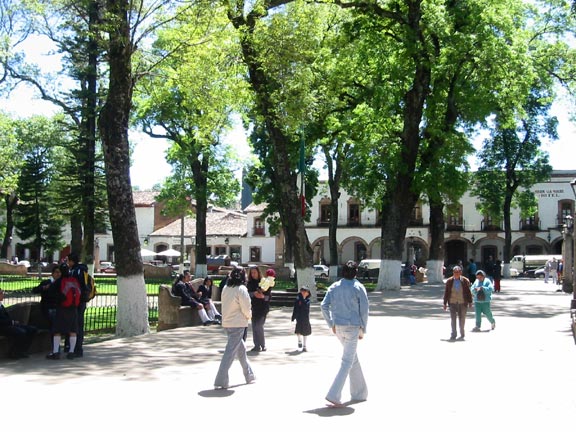
School Girls in the Plaza
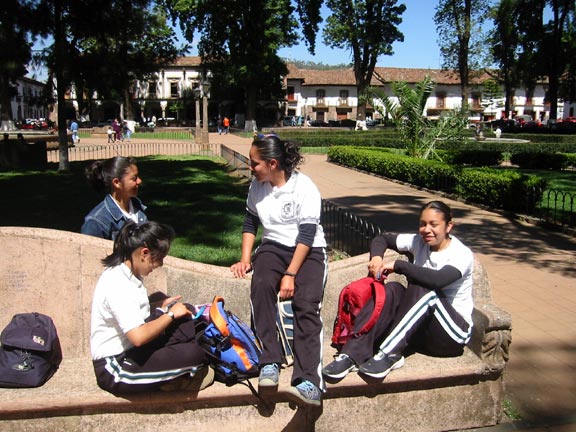
Library in Patzcuaro
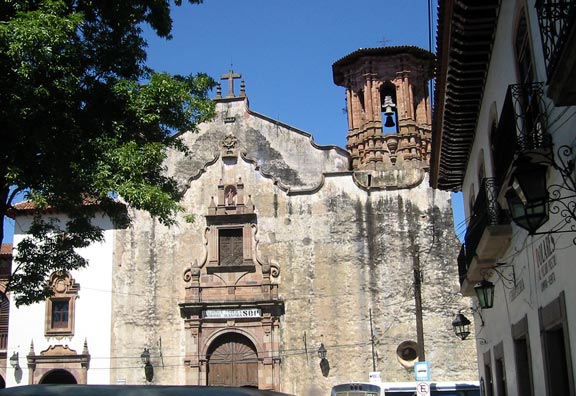
Yesterday, the 23rd of February:
I had only one goal, and that was to expand my knowledge of what nature Morelia was. First, I drove through several of the neighborhoods. I was reminded of the garish nature of advertising signs, the incompleteness of every building with their reinforcement rods plunging skyward, the inability of the people to keep their yards and streets clean and their buildings free of graffiti. Yet under this film, beats the hearts of a vibrant people. On the southern side of the city, I found cleaner and neater neighborhoods, and in the hills above this side of town were beautiful homes of the well-off, often just a stone's throw from the those with much less. I asked about what the better places cost. For a small new home, maybe it costs $35,000 USD and for the more elaborate villas anywhere from $100 to 300 thousand.
In the afternoon I spent quite a bit of time searching for an electronic map of Mexico on CD. I must have visited ten large stores, including bookstores, and could find it in none. It was clear to me that, even in a city of more than 500,000 souls, software is a hard thing to find. That pretty much leaves buying software to the internet. Yes, electronic hardware is everywhere - but not the stuff you want to run on it. The people, here as everywhere that I have been, love the internet. There is a store front with a internet connection on nearly every other block in el centro and every half-mile further out. The cost in this city is 15 pesos per hour and it was ten in Guadalajara. I was getting a strong signal on my cell, but I could not roam here. I was getting tired of always having to call home from the street; I broke down and bought a phone. Betty will be able to call me or send a text message anytime now. The cost for the phone and 200 pesos of calling was only $60 USD. This cheap phone may be usable in Europe too. Why Verison and the other US cellular companies don't use this technology is a mystery to me. I just have to get a new chip when I go to a new country. Easy, thank you TelefonicaMoviStar. The not finding what I wanted was frustrating, but it helped me to understand this place.
In the evening I went to a movie, the School of Rock. I would have to only give it two out of five stars, but it served the purpose of bring me home for a couple of hours. That is one of the nicest things about American movies when you have been away for a while.
Today, Tuesday the 24th:
I seem to be sleeping later and later. This is not really the best when on the road, but it is a sign that I am getting in to the swing of traveling live. My favorite breakfast is scrambled eggs with chorizo, beans, tortillas, and café con leche. Although I don't eat it every day, I did today. Then I was off on a day trip around Lake Patzcuaro. It is a beautiful area less than 30 miles away. Once I got to the lake, I drove slowly around it. I stopped in Patzcuaro. It is the largest and nicest town along the lake. The vibrancy was immediately noticeable. I walked a bit through two of its plazas. They were full of life. It is difficult to explain it to an American, unless they live in NYC or the heart of San Francisco, but I love it: from the street vendors, to the market places, to the greatly used open spaces, to the friendliness and openness of the people.
I continued my drive. I stopped a couple of times for a snap shot. The land about the lake is arid. Only an occasional field was green. This is a dry season, winter, even though the daytime temperatures are in the 60's and 70's. The area along the lake was dry. In the western US I have seen lakes with no vegetation. It exists here but it is scant or dried out. I would call these highlands (5000 to 7000 MSL) an arid region. I still notice the litter along the roadside, but it has either decreased a lot since my last visit or I am gaining a tolerance to it. I think it be the former. There is a clear effort by the government to decrease litter as signs discouraging abound along the highways. One of the sights that astounded me was an island, Isla Janitazio, in the lake that jutted up like the tip of a mountain. It was clear by the building that rose up along its hill that many people lived there. But still it was an odd looking sight.
Upon my return to Morelia, I set up some photos for my BLOG and head for this café. Now, I am read to send it out. It may be tough; the two glasses of wine have dulled the senses a bit.
For tomorrow I have no significant plans. I will try to spend the day studying Spanish, which is always in need of improvement. If anything else happens, you can be sure I will capture it in these pages.
Lake Patzcuaro, Isla Janitazio on the Left
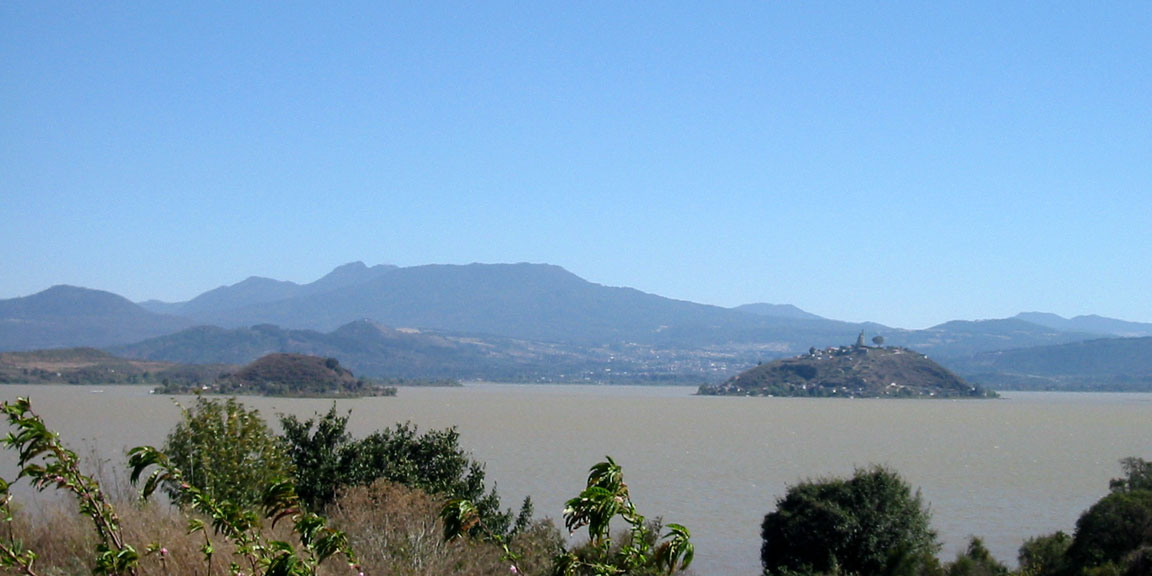
February 23, 2004
Guadalajara to Morelia
Press HERE to see a slideshow from
Guadalajara, Morelia and Patzcuaro.
Thursday, 19 February:
As I was saying in my last entry, I was at the beach, at Playas Novillero. The beach is wonderful, beautiful soft sand. There are very few people in living on the beach and almost no tourists. The room I took was ok. I could have had one that opened to the beach, sort of anyway, but I took another. When I got up this morning, I was disappointed to find no hot water. I decided to move on, but if all the beaches in Nayarit are like this, it would be a good place to spend some time if you could find the same with a little bit more life. After breakfast I was on my way to Guadalajara. The dry fields dominated the countryside, but I saw thousands of acres in agave as I approached Guadalajara. It was no surprise when I later discovered the town I was passing through was called Tequila.
I arrived in the late afternoon. It seemed that it took forever to find a place to stay. I did get a chance to see a bit of the city. Finally I settled. I went out to update this blog, and eat.
Friday:
I decide to leave the hotel, too noisy. I went to the information bureau. It is in a wonderful downtown area. The city has some fantastic public areas, with fountains and sculptures. As I drove about the city, I did not see an area that I wanted to stay in. The city and its suburbs has a population of more that three million and perhaps more than five million. It is dry, dusty, and hazy; pollution? I decided to drive around a bit. It was not a city I wanted to stay in. I am sure there are nice neighborhoods, but the ambiance was not what I expected. I decided to head south for Lake Chapala. The lake is gigantic, but the lake has been loosing water for years. The hyacinths have inundated the lake, not a pretty picture. Heavily developed on the north side of the lake, and almost deserted on the south side. The fields started to turn green as I headed down highway 15. I passed through dozens of small towns. And finally I put down in Zacapu. I went into the center of down after checking in. It is a typical small town, with a nice plaza and public spaces. I stopped for dinner. It was excellent. I hiked back to the hotel and put in for the night.
Morelia Main Street by Plaza
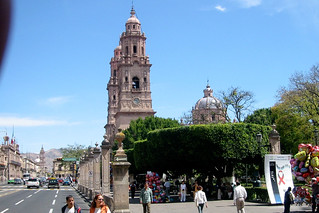
Fountain in Front of Old Aquaduct in Morelia
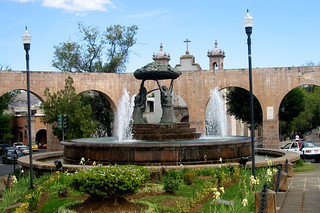
Side Street in Old Morelia
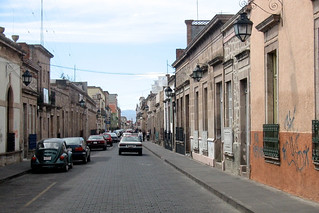 />
/>
Saturday, February 21, 2004:
I was only 84 km from Morelia, but I am sure it took more than two hours to drive there. It was the typical narrow two lane road with far too much traffic on it. Along the way I had some beautiful views of Lake Patzcuaro. If I get a chance I will drive back here and check out the area around the lake. The major delay as I approached Morelia was a public works project that was putting in new sewers and possibly rebuilding the road.
As I drove into the el centro, I knew this was a city that I would have to stay in. The colonial buildings have been carefully protected. The plazas and cathedrals were beautiful. I check with the tourist bureau. They had lists of hotels but really no information on the quality, cost, or additional amenities for each. I got some info on goings on in the city too. Then I went about the arduous task of looking for a place to stay. What made it so difficult was the irregular system of one-way streets. Finally, I found one that looked nice, with lots of character and big windows, TV and hot water. I studied a bit of Spanish and got ready for the evening. After a meal with too much beef, I walked through the central plaza. I had heard about a place with music and beer nearby, and I went there. It was not really what I wanted to see being more of a show, than a cantina. The manager was nice enough to direct me to Porfiriana, where one could find live salsa music and dancing in one room, a balladeer in another and pool tables in yet another. I wish that I had continued practicing the salsa dances that I had learning in Guatemala. It was really a great spot for an evening of fun. I watched people dancing and having a good time and drank beers until a little after midnight.
I walked back to my hotel. When I arrive I could here live salsa music play. "Where is that coming from?" I asked. There was a cantina in the basement. I thought, what the heck, I would check this one out too. I thought the place a bit strange. The music was good, and I thought the place was a just a more working class version of Porfiriana. The women were mostly big(!) and dressed provocatively, showing a lot of cleavage. I bought a beer for 20 pesos. Before long one of the women in the bar saddled up next to me and before long asked me to buy here a beer. "Sure," I said. The waiter asked me for 30 pesos. "No way," I said, "they cost 20 pesos!" For the women it costs 30 pesos. I told him and her to forget it. I asked the bartender if all the women in the bar work for the bar, and indeed they did. I put my half finished bottle on the counter and walked out. But I did not entire escape the sounds of the bar. The music and the noise in the street kept me up literally all night. The bar music stopped about 3 or 4 am. But the noise of cars and motorcycles drove me crazy. Why was there so much traffic? I peeked out the second story window. Many of the bar ladies were now on the corner below, selling themselves. Finally about 6:30 it quieted down with the earplugs from my Rio player that I put in my ears. I got about less than three hours sleep.
Sunday, February 22, 2004:
First thing I did after showering, was arrange for a different room. Then I ate, rested and took off to see much of the town and take some photos (see extended enty). When I got back I rested and started writing. I guess I am feeling better, even on three hours of sleep.
February 20, 2004
And so the adventure begins
I am in Mexico. It looks like a good beginning to me.
Sunday, February 15, 2004
The rain was supposed to stop today, so I choose it for my drive to Texas. No rain and when I got into Louisiana, the sun came out and warmed my soul. I drove through country that I have not seen before. I saw monstrously large swamps and later on when forests transformed into flat open lands I saw what looked like rice paddies. Between Lafayette and Lake Charles, I found a wonderful radio station playing Cajun music and announcers speaking the Acadian French of south Louisiana. East Texas was a land of hardwood trees and grassland with cattle here and there grazing the land. Houston is just another large city and did not seem at all special. About 6:30 I arrived in New Braunfels where I had hope to visit with a woman whom I had met a week before at the Rødspætte Klubben. But it was not to happen this night.
Monday, the 16th:
Before leaving New Braunfels, I drove through the town. I saw the small homes and the larger stone homes along the river. I drove though the center of the town. Nineteen century buildings dotted the landscape. I thought the place had a lot of character.
I stopped in San Antonio to see the Alamo. The old mission is in the center of San Antonio and is surrounded by tall buildings, some more than 20 stories. The buildings that were saved are well preserved. Laredo seemed more like Mexico than the US. The weather was glorious, clear skies and in the mid 80s. I stopped to pick up a few things, including car insurance. While not required in Mexico, I thought it prudent to protect myself. I finally crossed the border sometime after 3:30. Due to poor signage, I did not find the place to get permission for the car until 4:30. Despite the computers, they only had two clerks processing the paperwork. So, I waited in line. The bureaucracy here is not quite as bad as India, but it is still horrendous. It was a quarter to seven when I finished paying my $30. I decided to push on to Monterrey. It was less than two hours away. I missed seeing the country side, but the stars shown brightly above.
Tuesday:
After locating a map this morning, I headed for Highway 40 to Torreon. Mexico has developed a large number of toll roads. They are some of the most expensive on the earth running roughly one peso per kilometer, which is about $15 dollars for 100 miles. I had decide to pay the extortion while drove Monday night. However, today I rode on the free highway. It was decent. The only problem that I had was getting through Torreon and onto the correct highway. The signage was not what it should be. Two cops hit me up for driving too fast in the town I guess they get you one way or the other.
With the mountains off in the distance, one might have thought the scene would be lovely. But this was a sparse desert with little growing on it and almost no one living here. On the other side of Torreon and the way to Durango, then desert gave way to fields and grazing lands. It was quite beautiful. The free road was not a beautiful, rough and full of semi-trailer rigs. Eventually I made my way back to the toll road. I saw no other car or truck going west. On the other side of Durango, I found some of the most beautiful scenery so far as I drove up into the mountains. The two lane road was new and in fairly good condition. But the turns were dangerous, not to mention the lumber trucks going the other way. The couple of towns I drove by were poor. The smoke from their chimneys smelled wonderful. I stopped for the night in the largest of these towns, El Salto.
Wednesday, February 18, 2004:
It seems like I am making little progress. I wanted to be lying on a great beach this afternoon. And it took me until night fall to locate a place. I was up early this morning. The 270 km. Drive to Mazatlan, was extraordinary. The drive through the mountains was one switchback after another. So much so that I was getting motion sickness, which is no mean feat for a flier? There were only a few places where the road was not good. With all the semis using the road, it is a necessity. So I was off at sunrise, about 7:30. I didn't stop until I knew I was out of the worst of it about 10:30 and after about 150 km. The average speed was no better than 40 mph. After the breakfast stop. I drove to Mazatlan. I drove the entire beach area of the old town and the new resorts. This is not a place where I wanted to be. I think Acapulco has more ambiance than Mazatlan; and compared to the Yucatan or Bias de Haultoco, I would classify it as a serious downer. I found the tourist bureau. Based on there advice I tried Teacapan, an town about 50 miles south. Nice but it had no sand beach. If I could have flown to the place I ended up it would have taken less than one half hour, but I had to double back 25 miles and head south on an inland road.
An hour and a half later I finally got a place on the beach - Playas Novollero, where I now sit and write. The weather continues to be excellent. It was cool in the 30s in the mountains, and in the 90s in Mazatlan. The wind is blowing and it finally has cooled down on the beach.
Thursday:
The promise of hot water was not delivered. It is foggy over the ocean. I pressed on to Guadalajara. A beautiful drive it was.
February 15, 2004
On the Gulf Coast
I left Tuesday morning and headed south. The weather was good for driving. It was not too cold, about freezing. Snow covered the ground and fields but not the road all the way to St. Louis. Three weeks before it was colder, but there was no snow on the ground. For the three weeks before I left this frozen northland, it had snowed almost constantly. It was clear that the snow had pushed far to the south. But it was so much warmer in St. Louis. Wednesday morning, I visit a graveyard in Bellefontaine, where my grandmother's grandfather, Horace Wright, is buried. His second wife and two daughters were laid to rest next to him. I also found a man I believe is his brother, Rev. Edmond Wright. It opens some new lines of research. As I drove out of St. Louis, the skies were gray and snow still layered the fields. Eventually, the snow disappeared and gave way to the bare fields of winter, resting for the spring sun and warmth to bring new life to the land. By the afternoon, I was in northern Mississippi. It started raining. The road was wet, but the rain was not coming down hard enough to slow me down much. The fields faded in to the yellow pine forests of Mississippi. I arrived at my dad's house about seven. Diner was ready and on the table. What's it like in Ocean Springs, Mississippi? In the 50's, it is so much warmer than single digits of the Twin Cities. The rain and humidity bring a wonderful change to the dry air of the north. Despite the rain and gray, I am really enjoying my time here. The only thing better would be some sun and heat. The last couple of days have been full. We caught up on our lives after hours of conversation. When not talking I helped dad with his new computer. We went out and bought a new scanner and printer to go along with the new PC dad had built. He also got the stuff to set up a DSL line. I hooked up the DSL line and setup and installed the scanner and printer. Everything seems to be working well. All-in-all it was quite an advance for my day, who seems to have finally burst into the 21st century. One of dad's friends dropped by to give him something. His name was Paul Hannesson. He is an old man who was born and raised in Iceland. We go to talking and he told me a good fishing story. In the early 50's ,he worked on an American military base. One of the servicemen, Hurbert Tutwiller, befriended him. When Paul would go fishing Herbert usually wanted to go along and often did. They would head out to the wilds where the trout ran thickly in the streams. No pole, just drop a line in with worm from under a rock and the fish was yours. First time they went out they were fishing near a hot springs, a steam vent. When Herbert caught that first one Paul asked: are you hungry? Do you want to eat it. Paul was taken aback a bit but finally said, "Sure, but how are we going to fix it?" Not to worry. They stepped over to the hot spring; Paul hanging on to the line dropped the fish in to its head. Sixty seconds later, it was done. Paul and Herbert filleted and ate the cooked fish. Herbert loved it. He noted that this was the freshest fish he ever ate. Years later he wrote to Paul say that these were some of the most memorable days of his life. The local communities are already sponsoring Mardi Gras parades. I was kind of wishing that the real Fat Tuesday would be just around the corner. I would certainly hang around for all the craziness. But alas, that is not to be. Tomorrow I will be heading for San Antonio - a mere 600 miles away.February 09, 2004
The Weekend
Not Even for the Birds
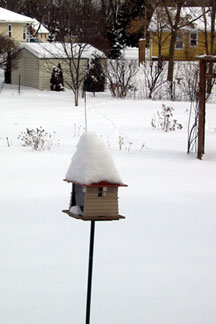
I saw an old friend, Beth Held, on Friday night. It was good to hear that she finished her college degree, and has a new job. I was just a little sorry to hear that she was still working for the City. I brought my collection of photos. I am using the Adobe photo album to organize and display them. I hope to be able to put the good ones on my web site one day.
Yesterday, I went to a Rødspætte Klubben. It was great to see so many of my old friends: Kim and Liz; Manja and Jørn; and so many more. They have changed the music venue. No more old guys playing an accordion and a fiddle; nor more polkas; now it is a small blues and rock group. Thank-god, they knew not to blow our ears off, plus they sounded pretty darn good. The aquavit (schnapps) and gammel Dansk tasted good, the kringle was better, and the fish, the Rødspætte, was great.
I got to get out of this place!
The cold and snow outside is the bane of my existence today.
So I am heading south. Not even the birds can take this weather. The next time I write, I will be in Mississippi.
February 05, 2004
A Day in the Air
My Sport and I in Warmer Days
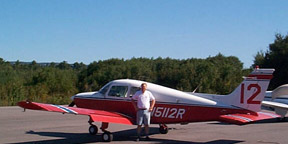
I wanted to go flying yesterday. Although very cold, the sky was clear and extremely blue; the sun was bright and all looked well. Hangers in the Twin Cities have become so expensive to rent that I keep my Sport out side most of the time. But there was six inches of snow on the plane. After cleaning it off, I tried to start it; too cold! It just wouldn't kick over. Normally, I just plug in the heater and wait an hour. But there was snow all around the plane. If I had totally dug it out and pulled it up to an electrical outlet, it would be too late in the day to fly. So, I put it in a heated hanger for the night. The nominal charge was $15.
So today I was off. I flew for about five hours. I flew using the instrument, because the weather was not all that great. I wish that it had been more like yesterday. But all in all, it was a very enjoyable day. I love flying!
February 02, 2004
Snow, Snow, Snow
As so often happens, after a super cold period with warmer temps, the snow begins to fall. It warmed up into the 20's (-5 to -10c), but it started snowing. It's been snowing for two days now. So far it looks like 12 to 16 inches (30-40 cm) in the yard. The neighbor helped clear some of the driveway yesterday, but it still took an hour to clear it fully. This afternoon, it was more than an hour of shoveling and clearing snow. If it were not for the booming economy in Minneapolis, I am sure there would be only a few people living here. With the economy, the city grows and grows.
I did not get much done today, except pick-up some beer at the brewery and clean the driveway.
I am really looking forward to escaping the tundra. I leave for Mexico in a week.
February 01, 2004
Hung Over and More
I was a bit hung over this morning. I took Adrian Jimenez out for drinks in the early evening. I have not been in the Uptown area of Minneapolis in the evening for years. It was a treat to be in this artsy-fartsy area. After eating and drinking at William's Pub, Adrian went home and I went over to Chino-Latino. It was fun and I found a couple of people to talk to. But this morning I was hung over.
I did some work on trying to understand this BLOG a bit. And I did some work on the family tree, after my dad told me that a cousin of my grandpa lived in the US. But I could find no information on the web about him.
A real genealogical treat came in the mail today. I have been talking to one of Betty's cousins in IA, Dorothy Bahlmann. She claimed to have a photo of Betty's grandmother and grandfather's wedding. Well, the photo came in the mail today. It can be seen in the extended area of this blog.
The Wedding of
Theresa L. Hensler and Michael G. Seiler
23 November 1909, St. Paul, MN
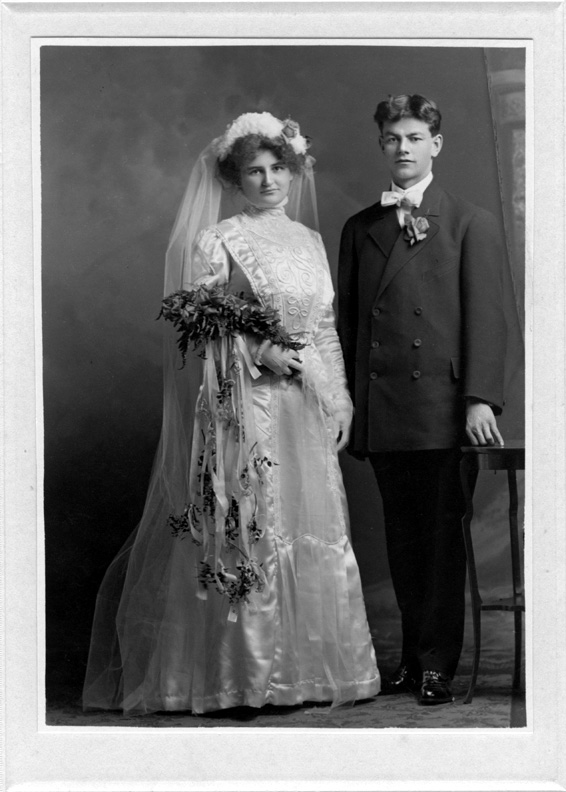
This image is only suitable for viewing.
Eventually I will make a high-resolution copy suitable for printing available.
